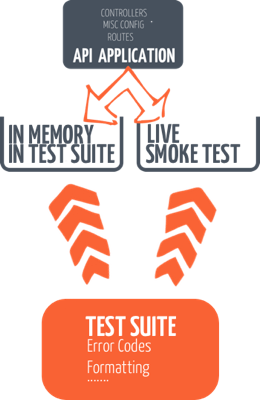Integration Testing ASP.NET Web API
Want to know what kind of HTTP APIs suck? The ones that break all of their clients every time a new version is minted. Everybody shipping an HTTP API, shoud have one question at the top of their mind.
Is this change going to break my existing clients? How can I keep breaking changes to a minimum?
One way to be sure that you arent going to build one of those APIs, is to set up a series of automated integration tests. In this post I will show you an approach I found helpful to integration testing HTTP APIs built on top of ASP.NET Web API.
Test With Zero HTTP Traffic
The utopia of an API integration test suite, would be a suite which could be executed quickly, and in memory, on our dev machines. Without any HTTP traffic. This would allow us to more quickly become aware of breaking changes at the boundary of our API. Wouldnt it also be great if we could then take those same tests, and run them against our test deployment?
To do this, we need to design our API in a way that supports a host anywhere — test anywhere mentality. Our application must first be designed in a way that can be started in both the IIS hosted environmnt, and the self hosted environment.
Encapsulating the root of our API application is an important first step. When either the ASP.NET web host, or the self hosted API kicks off, it is able to call into our API application and call Start(). At this point all the configuration required for API can be carried out.
1 2 3 4 | |
When our hosting environment starts, we are able to carry out all the configuration required for our API application to run. We can attach all of our custom message handlers, add any custom media type formatters, and configure our routes. What this achieves is a way for us to bootstrap our API, independent of the host infrastructure.
1 2 3 4 5 6 7 8 9 10 11 12 13 14 15 16 17 18 19 20 21 22 | |
Now we can take our IApiApplication, and place it in a different host. Each host is able to call Start(), and magically our API is bootstrapped in the way we expect.
Testing the API application
This is great news for our integration test suite. We can now take our API, which we may have previously hosted inside IIS, and host it in memory — inside a test session.
Start out by creating abstractions in your API server
1 2 3 4 5 6 | |
We can now create a version of the API server, which is responsible for starting the API applciation, and hosting it inside our unit tests.
1 2 3 4 5 6 7 8 9 10 11 12 13 14 15 16 17 18 19 20 21 22 23 24 25 26 27 28 29 30 31 32 33 34 35 36 37 38 39 40 41 | |
From our test project now we can write test fixtures which start the in memory server during the test fixture setup phase, and tear it down when they are done.
The IApiServer exposes a ServerHandler. We are going to use this handler to take advantage of a neat trick exposed by the HttpClinet, which will allow us to pass the server code directly to the client. In this way ZERO HTTP traffic will be generated.
1 2 3 4 5 6 7 8 9 10 11 12 | |
1 2 3 4 5 6 7 8 9 10 11 12 13 14 15 16 17 18 19 20 21 22 23 24 25 26 27 28 29 30 31 32 33 34 35 36 | |

It gets better!
Is there a way we can take the integration test suite, and execute it against a real server running our api? Perhaps in a test environment. Absolutely. In fact, I would encourage you to do this, and luckily, our test suite supports this.
1 2 3 4 5 6 7 8 9 10 11 12 13 14 15 16 17 18 19 20 21 22 23 24 25 26 27 28 29 30 31 32 33 34 35 36 37 38 39 40 41 42 43 44 45 46 47 48 49 50 51 | |

Above, I have turned our unit test into abstract class, and created two test classes which inherit from it. One executes the tests against the InMemoryApiServer, and the other, against the Test Server. Allowing the same test suite to be quickly executed in memory, and against the test server when we are ready to.
You may not like using abstract classes in unit tests in this way. Great! Feel free to take these ideas and mould them into your own approach. The thing that I personally have found helpful in this approach has been, it has allowed me to build a comprehensive suite of tests, which I can run before I check in. Equally on the build server, I can make up the tests which execute against the test environment, with an nUnit category (or similar in your test framework of choice) and run those tests as part of a longer running build.
I hope you were able to find something in this approach that may help you do the same.
As an aside many parts of ASP.NET Web API are built in a way that supports unit testing. This blog post focuses on a different kind of testing — integration testing. I would encourage you to unit test your components in the first instance.
Checkout the tests in this sample project as an example Hyper Library